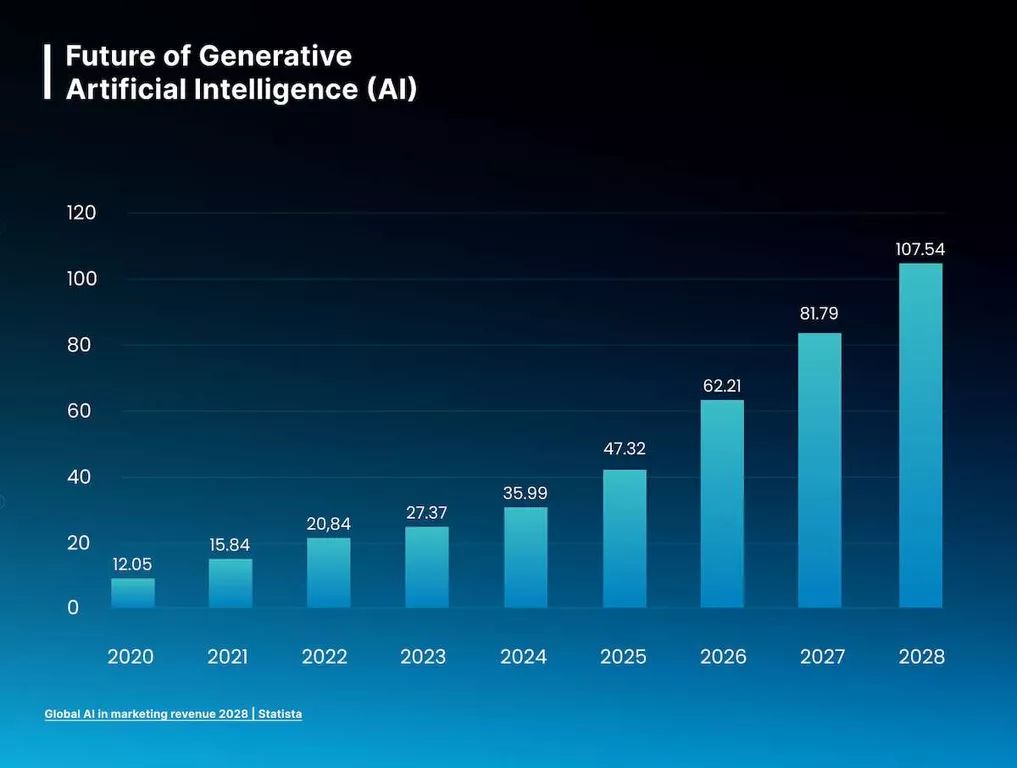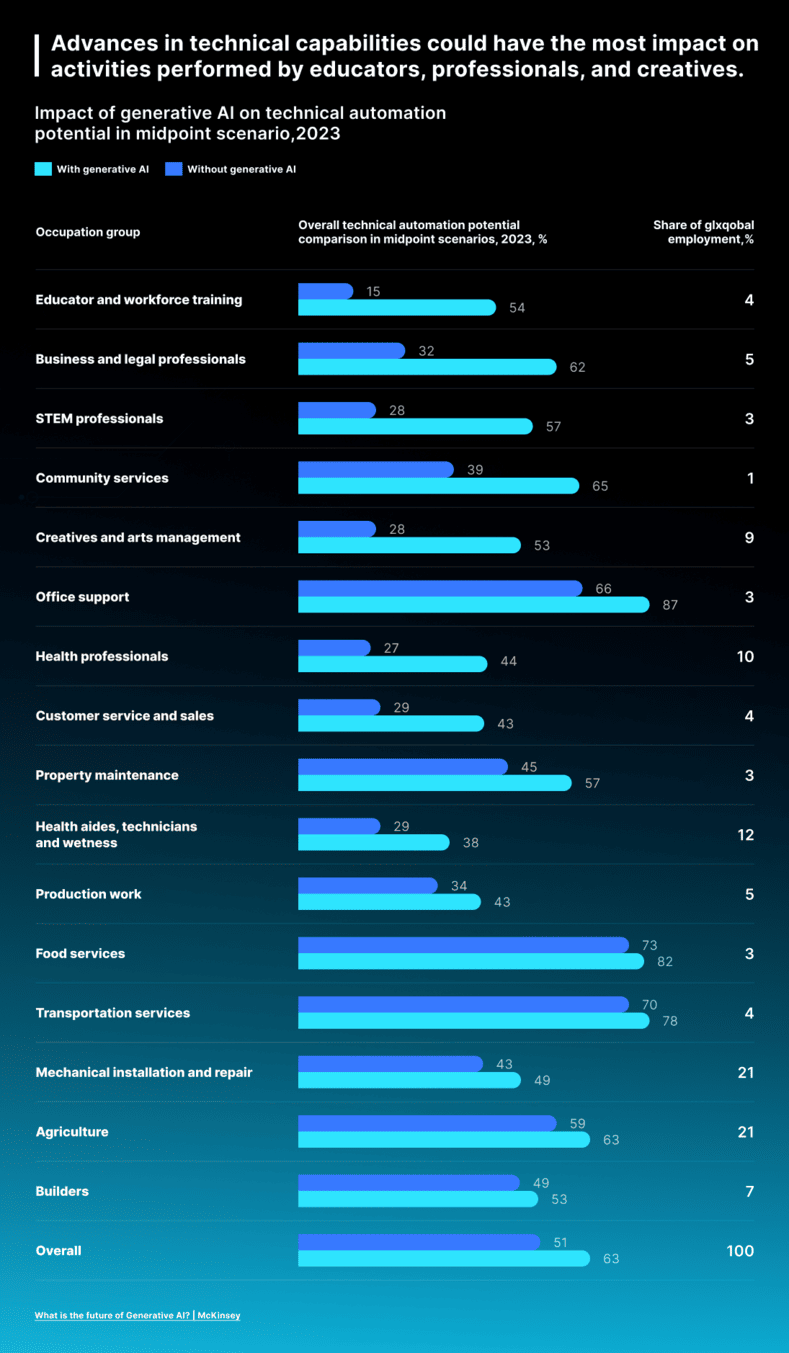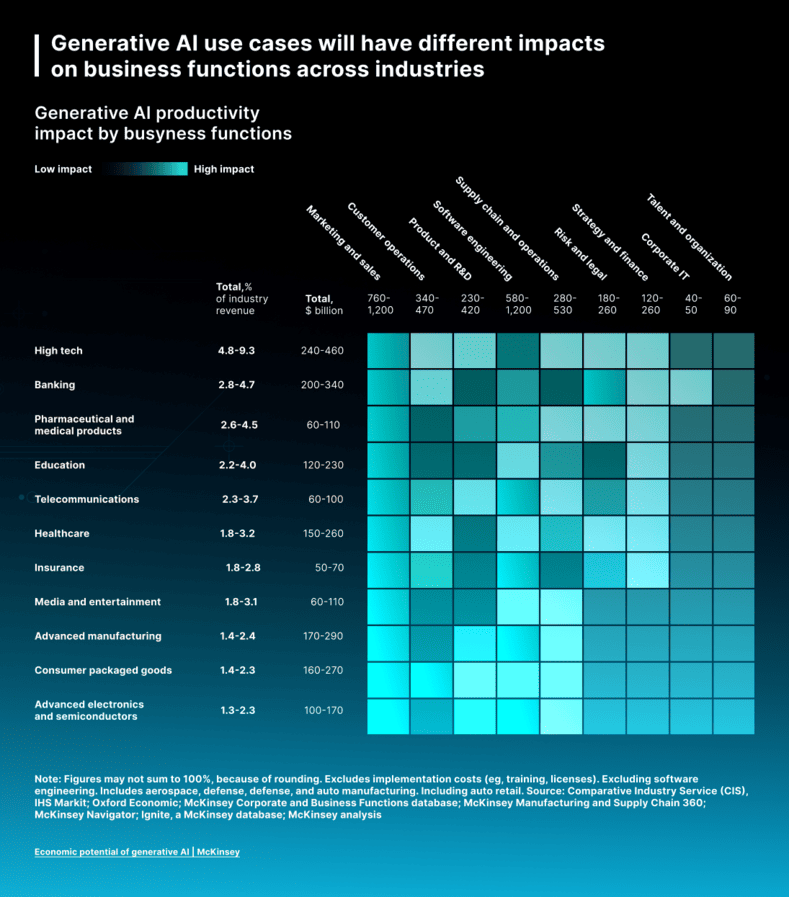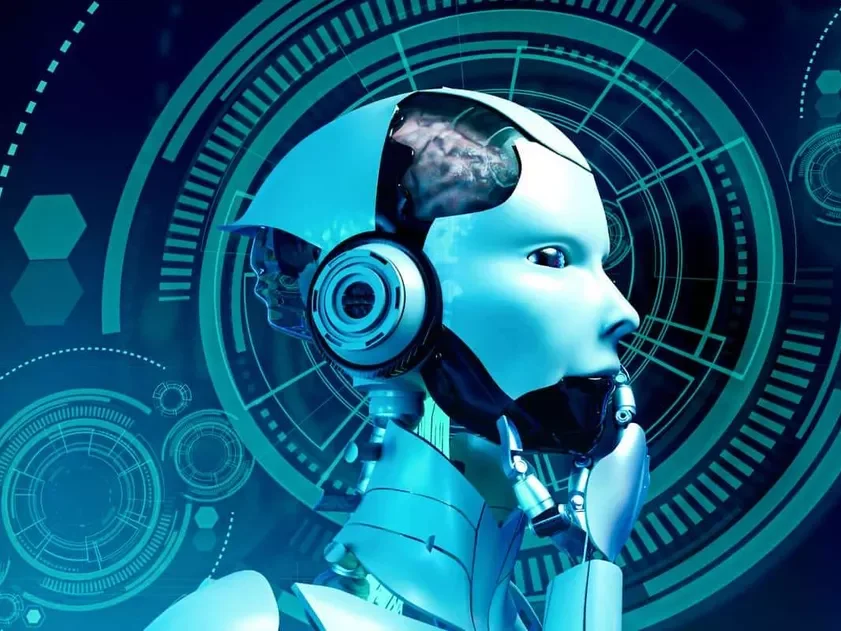In the modern world, artificial intelligence is becoming noteworthy. We can’t afford to be unprepared for the future of AI. Understanding the fundamentals and guiding ideas of AI is crucial for preparation. Furthermore, it’s critical to be informed about the most recent advancements and comprehend how they impact society if you want to stay one step ahead of your competitors. Thanks to ML, computer vision, and natural language processing, you’ll advance.
The marketing expenditure for AI in 2021 was $15.84 billion. According to Statista projections, this figure is to rise by 678% by 2028. It’s hardly unexpected, as firms continually seek ways to increase efficiency. In this article, we’ll touch on six instances of how different sectors may change due to generative artificial intelligence.

What Makes Generative Artificial Intelligence Important?
Countless industries are transforming due to the innovative, creative, and problem-solving capabilities of generative artificial intelligence. The CEO of MSM Digital, Mario Mirabella, has revolutionized consumer engagement and strategic approaches using this technology. This breakthrough is highly significant as it attains previously unheard-of efficiency. It is also essential to consider how well it raises revenue and improves consumer happiness. According to a PwC analysis, artificial intelligence technology will boost global GDP by $15.7 trillion by 2030. It just highlights the enormous impact of artificial intelligence.
Generative AI facilitates creativity and clears the path to concentrate on worthwhile projects. AI automation of monotonous processes and the refinement of operations have made it feasible. To a lot of entrepreneurs, it is just a trend to follow. But to increase profitability and competitiveness, you must realize that utilizing generative AI is a strategic need.
Lead generation is one such transformational use. With the use of AI-based technologies, the Mirabella team has wholly redesigned customer service. AI identifies potential clients with high accuracy because of meticulous data analysis. It reveals their habits, demographics, and interests. Thanks to the abundance of info, designing hyper-targeted advertising is a piece of cake. Each audience segment finds them particularly compelling due to their unique design.
And your team might also obtain precise outcomes and save time with the help of AI. MSM Digital illustrates how AI is changing business and how the potential of artificial intelligence allows us to reconsider our approaches to implementing new technologies.
Artificial Intelligence Trends in 2023
You cannot keep up with the times without understanding the latest trends. Let’s look at the main ones that have shaped our world today.
Merger of offline and online worlds
Any area dealing with business can no longer only be physical or exist without AI. It doesn’t, however, imply that conventional businesses eventually vanish. Using AI to boost their worth to clients is the primary task. To illustrate, Walmart’s grocery store uses AI in trial markets to monitor product availability, quantity, and expiration dates.
Taking healthcare by storm
For some time now, AI has shown to be effective in diagnosing a wide range of illnesses. Additionally, last year, scientists from Melbourne used AI to assist them in creating an antibiotic to combat the superbug Acinetobacter baumannii, which may cause fatal skin, blood, and respiratory infections. Despite the superbug’s resistance to all available medications, AI allowed scientists to choose specific chemical components to produce an antibiotic that might combat it.
Prosthetic limb adjustment is another use of AI that has launched out. A person who has lost a limb may find it challenging to adapt, and prosthetic adjustments may take months for medical professionals. Prostheses using artificial intelligence to adjust to human motions are settlements of a problem.
Smart flats and cities
These days, a lot of thermostats let you use your smartphone to change the apartment’s temperature even when no one is home. The robot vacuum cleaner has algorithms built in to assist it in calculating how much water is needed for a particular cleaning.
Apartment devices will eventually recognize speech or human input and direct orders. The system remembers the user’s orders and, upon realizing them, modifies the air conditioning or heating settings. Furthermore, entire cities where the Internet of Things permeates daily life arise, rather than just an apartment.
Revolutionizing content creating
AI might produce customized books and music according to a person’s preferences. A McKinsey & Company study claims it even identifies the precise factors influencing people’s emotions. In the not-too-distant future, firms employ AI to create content which has the power to control human emotions more effectively than any director, musician, or writer.
Advantages of the Future with AI
Numerous potential advantages of AI exist. People must be ready to figure out how to collaborate and be aware of the implications if they want to reap the most rewards. Let’s dwell on top benefits:
- Increased productivity. AI spruces up productivity across a range of sectors. Businesses of all sizes profit from the enhanced workflow and decreased time consumption.
- Enhancing medical treatment. It improves diagnosis and therapy in the medical field. AI may assist medical professionals in making more precise diagnoses or treatment recommendations.
- Raising the level of social mobility. It potentially boosts social mobility by giving previously unattainable people new options. It may assist the unemployed in finding new employment or generate new occupations for those with robotics or data analytic abilities.
- Strengthening societal integration. Through facilitating more efficient interpersonal communication, AI has the potential to enhance societal integration. People can use it to make friends with each other and advise on subjects which interest them.
Last but not least is assistance for small enterprises. AI creates the desired illustration in a few seconds. If a tiny coffee shop needs to take a picture of a cake, AI can do it instantly for free. It eliminates the need to hire photographers and spend time and money preparing the cake.
6 Examples of the Future of Artificial Intelligence
Progress never stops. Work process automation contributes to increased worker productivity. The primary goal of AI is to facilitate customer communication. While such a technology or system can mimic human behavior, it cannot fully take its place.
The growth of AI has accelerated data processing and transmission, much like the Internet did. It can learn and mimic human behavior to execute various activities, allowing it to speed up and even simplify complicated operations. Instead of trying to take the position of a human, it aims to support and enhance human intellect. Therefore, it’s hard to imagine a future without this tech. Let’s examine six future applications of AI in pivotal sectors.
Health care
Today, the world confronts the severe challenge of guaranteeing everyone access to health care. Shortage of trained physicians, poor infrastructure, and other issues contribute to it. Many individuals lack access to medical support. Here’s where innovative solutions enter into the picture — AI is becoming a revolutionary tool. Using information from medical records or fitness monitors it can make diagnoses. When examining the trends, the AI recommends suitable medications and uses technology to streamline the procedures.
The use of AI in clinical practice in cardiovascular disease will likely pick up speed over time and eventually encompass all aspects of risk assessment, diagnosis, prognosis, and therapy. Imaging and EKG technologies, which will increase the repeatability and precision of measurements, diagnoses, and treatment choices, should soon be available in hospitals.
Dental radiology also makes active use of AI and neural networks to help with diagnosis, planning, and treatment result prediction. Neural networks have the ability to both identify dental restorations or caries and assist in selecting the best caries treatment strategy in restorative dentistry.
The healthcare AI models, which MetaDialog has explicitly developed, help you create a new business strategy. The development firm knows how crucial your patient relationships are to you. As a result, it provides you with local language models to assist you in various scenarios. Chatbots may help with appointments, patient requests, and round-the-clock support. Using AI-powered analytics to develop individualized treatment plans based on each patient’s unique medical history enhances customized care.
Education
The basis of the development of any nation’s future is its youth. Therefore, the knowledge young people receive becomes a priority. Let’s look at the primary instances of the future of artificial intelligence:
- Removing the routine learning process and giving intelligent assistants control. Organizing the school as a safe physical location is an excellent place to start. It might be security control or monitoring of energy use. Specific systems identify students about to commit crimes based on their movements and body language.
- Ensuring every student has a unique learning path is another way to promote development. Students’ desires, demands, and interests should be considered on the one hand. Conversely, the extracurricular education system that the school offers is another option. AI may help schedule and streamline it.
- Based on the student’s eye movements—including whether or not he is seeing the text for the first time and how long he is focusing on the task—it is possible to assess learning outcomes and pinpoint areas that require improvement. Such AI programs could be a must in assessment centers.
- Every student may have access to a personal assistant such as Siri or Alexa — a constant virtual helper. Because the system has sufficient data and experience, the neural network learns independently. And then it’s possible that the ancient philosophers’ dream—that every citizen should receive an education from a philosopher—will come true.
The list goes beyond, as education is a primary field to AI to reveal its whole power. McKinsey notes that educators have the most significant advantage from this tech. According to the info, without AI, the total technical and automation potential is 15%, and with AI – 54%. It means that the potential increases almost four times.

Finance
It’s another sector which can’t realize its full potential without AI. According to estimates, the technology might offer value to the financial sector equivalent to an extra $200 billion to $340 billion yearly in the future. Therefore, AI is a must in shaping the economic sphere’s future:
- The development of virtual personal assistants is possible with AI methods. Such an assistant constantly reminds you to make a required payment, alerts you to a potentially dangerous activity, or provides information about the bank’s services. Either a “faceless” chatbot or a produced video consultant, it’ll always be able to assist and even take over some regular tasks like paying bills as it’ll always be aware of all the facts about the customer.
- Furthermore, there are dangers involved in the numerous decisions financial institutions make. Should I provide a new corporate customer with a loan? Must we establish a new branch? How should capital be distributed? These and countless more problems may have perfect answers thanks to artificial intelligence. Naturally, nobody can promise these suggestions will always be accurate. But when it comes to making some financial judgments, the ability of AI to evaluate massive amounts of data will drastically lower risks.
- AI’s speedy analysis of massive volumes of info will be helpful in the battle against fraud and other illicit activity. Pinpointing unusual or suspicious activity involving electronic payments and financial transfers will simplify it. It’ll be feasible to locate illegal transactions by examining several factors rather than combining all unusual payments into one category.
- According to a recent Wealthramp research, many millennials prefer technology-based financial advice and use robo-advisors and other digital tools when investing. Furthermore, the discipline of bionic advising has emerged, combining human intuition with computational analysis to enhance customer connections more successfully than each approach could do on its own.
With a cutting-edge AI solution tailored to financial institutions, MetaDialog takes your company to new heights. Using its platform, you handle customer support queries and go above and beyond. Additionally, you may give customers individualized financial advice based on their goals, spending patterns, and risk tolerance.

Military and cybersecurity
In the future, AI might help military tech develop autonomous weapon systems. They will be a less risky way to increase national security without requiring human involvement. There could be an increase in army robots soon. Their intellect is comparable to that of troops or special forces, and they carry out a variety of jobs. The goal of integrating AI is to make the mission more effective. Prioritizing security throughout execution at the same time is another critical factor.
Still, questions remain regarding the explainability of algorithms, given the ambiguity of AI-enabled systems. It is imperative to produce comprehensible artificial intelligence, particularly given the deep neural network’s complexity and quick evolution. Not to mention the dangers of technology like this getting into the wrong hands. Thus, there is a likelihood that responsible and intelligible AI may transform both the military and cyberspace.
Transportation
Future of AI in transportation is developing at a breakneck pace. Flying cars are perhaps the only thing that is still a ways off. Forecasts indicate, by 2025, the percentage of cars integrating AI-driven technology will have risen significantly from 8% in 2015 to 109%. Let’s look at the top future trends:
- Connected automobiles are the real deal. They have predictive systems installed, which successfully notify drivers of possible issues. These kinds of systems offer directions, set emergency procedures, etc.
- AI also contributes to increased public transportation safety. Have you seen strange activity at bus and rail stations? AI cameras keep an eye on it. Facial recognition software powered by AI may also reliably identify travelers and spot any dangers.
- Using AI may enhance the user experience. Chatbots respond to inquiries from travelers and give them information on the current traffic state.
Recommending transportation choices based on the user’s requirements and preferences is another usage of AI-based customization solutions.
Advertising
AI-powered systems use previous data to replicate campaigns. It allows marketers to obtain insightful customer data, preferences, and behavior. They may construct individualized marketing strategies by facilitating more accurate audience segmentation using ML algorithms and deep data analysis. The Dash Hudson service, as an illustration, forecasts the results of posting various types of content. In addition, he will offer suggestions to develop a conversion graphic taking into account current trends.
Furthermore, sophisticated sentiment analysis techniques streamline the outreach to prospective customers and enhance lead generation and sales conversion.
Wrapping Up
Knowledge-based work automation is not too far off. It has the potential to completely transform industries like education, finance, tech, and the arts which significantly depend on teamwork and decision-making. A factor in the change is the capacity of generative AI to identify patterns in natural language. It’ll cause the predicted automation of some of these experts’ occupations to happen sooner than planned. Gen AI tools have already proven incredibly adept at producing textual, visual, and audio content. The future of AI holds more specialized apps offering more excellent value as businesses continue to build applications tailored to specific sectors and services.
We must come to terms with artificial intelligence’s presence in our lives to realize its promise fully. Today’s civilization has already seen several changes due to AI. But it is a portion of what is ahead for us in the future. Down the road, more individuals will utilize artificial intelligence-powered devices, such as virtual assistants and robots. We need to learn how to use these tools to be ready for this brave new world and be conscious of their potential when they become widespread. MetaDialog provides the knowledge and resources you need to prepare for this unavoidable age of artificial intelligence. Keep up with MetaDialog: discover AI services and be ready for a more smart and connected future.
